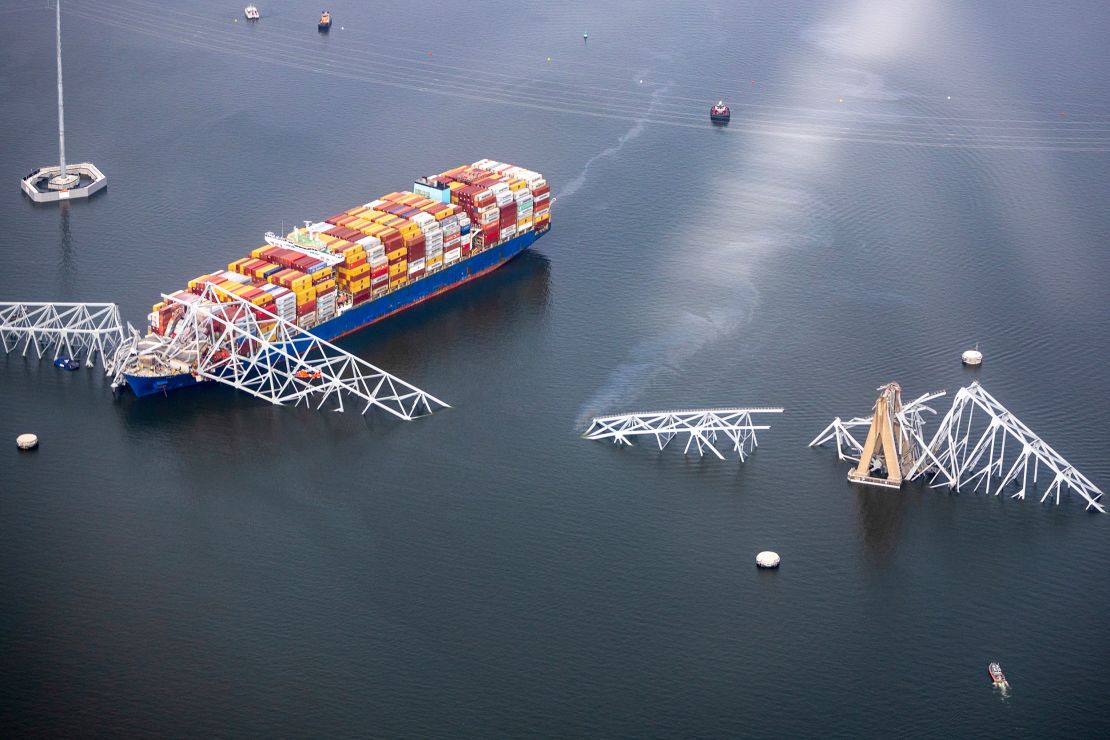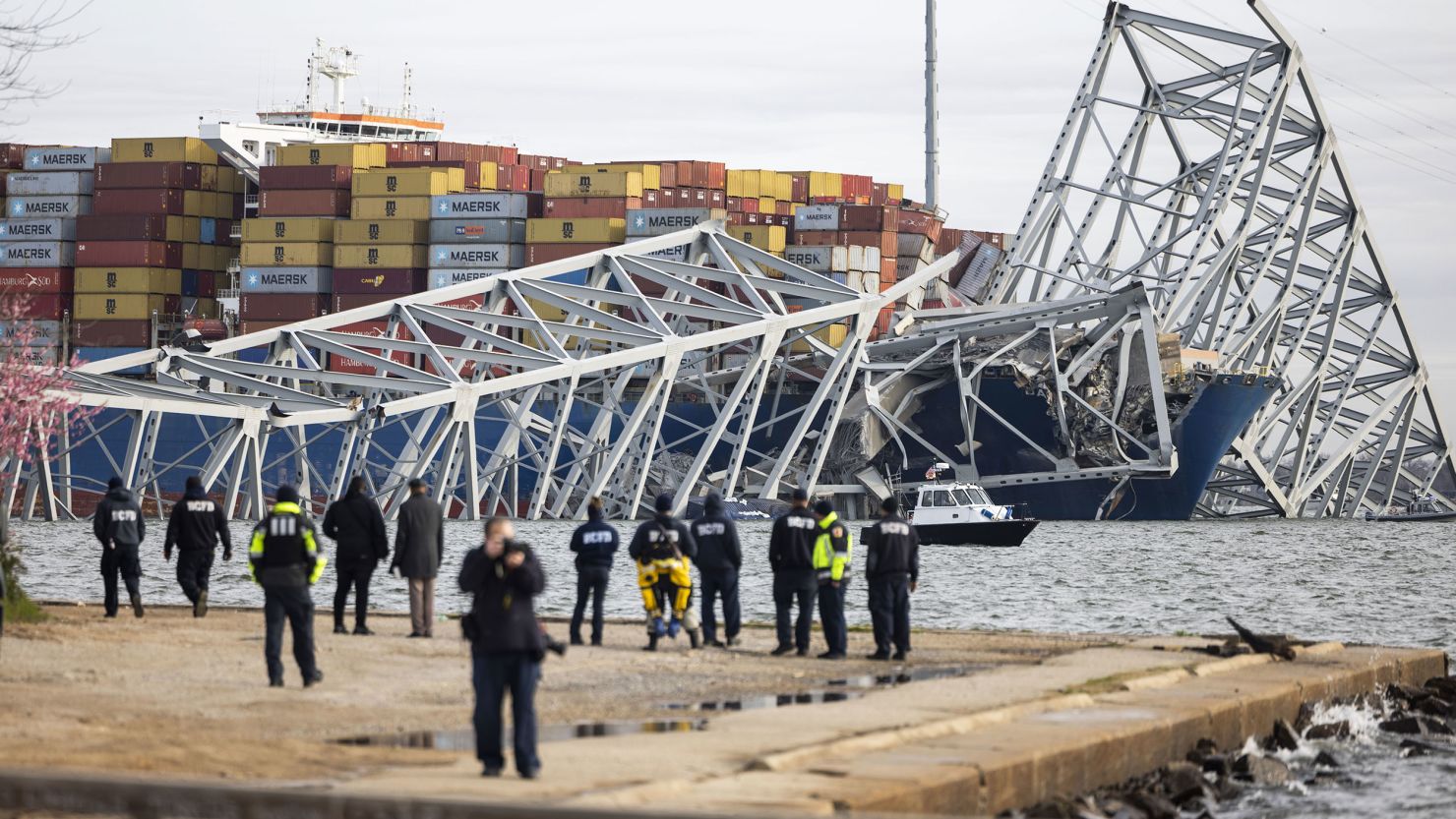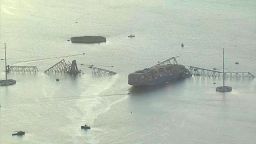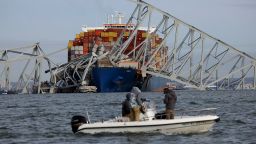Perhaps the most obvious cause for the collapse of the Francis Scott Key Bridge in Baltimore early Tuesday is what’s seen in footage from the scene: a massive cargo ship laden with shipping containers striking the bridge, which buckles into the river below.
It’s still early in the investigative process, but officials have ruled out terrorism as a motive; Maryland Gov. Wes Moore said at a news conference Tuesday morning preliminary information indicates the collision was an accident.
How the collision occurred, as well as whether any preventative measures could have helped mitigate the bridge collapse, will be a focus of the investigation led by the National Transportation Safety Board. In the day since, however, investigators appear to have attributed the collision in part to a power issue reported by the crew onboard the vessel – a Singaporean-flagged ship named DALI – just before impact. Meanwhile, experts who spoke to CNN indicated the ship struck a crucial support column, or pier, that the Key Bridge could not stand without.
Given the ship’s comparative size – 984-feet long, and 213 million pounds – it was more than the bridge could endure.
“What we do know is a bridge like this one, completed in the 1970s, was simply not made to withstand a direct impact on a critical support pier from a vessel that weighs about 200 million pounds,” US Transportation Secretary Pete Buttigieg said Wednesday, “orders of magnitude bigger than cargo ships that were in service in that region at the time that the bridge was first built.”
DALI was as “wide as the bridge was tall,” said Benjamin W. Schafer, the Willard and Lillian Hackerman Professor of Civil and Systems Engineering at Johns Hopkins University.
“Take a ship that’s as big as a bridge and run it into it,” Schafer told CNN, “and the bridge isn’t going to win.”
Here’s a look at the factors that may have contributed to the collapse of the Francis Scott Key Bridge.
Ship reported ‘power issue,’ lost propulsion
At the time of the collision, the 984–foot–long DALI was leaving the Port of Baltimore and bound for Colombo, Sri Lanka, officials said.
But moments before impact at 1:28 a.m. ET, the DALI reportedly lost propulsion and dropped its anchor, according to a statement by the Maritime Port Authority of Singapore, citing a report from the ship’s management company, Synergy Marine Pte Ltd.
“As a result, it was unable to maintain the desired heading and collided with the Francis Scott Key Bridge,” the statement said.
Moore confirmed the crew informed authorities of a technical problem just before the crash, warning them in a “mayday” call of what he called a “power issue.” That allowed authorities enough time to stop more vehicles from crossing the bridge, said Moore, who credited that warning with saving lives.
Indeed, the ship veered toward a pillar shortly before impact, according to a CNN analysis of MarineTraffic ship-tracking data. Any power issues may be corroborated by the footage of the incident, which showed a plume of dark smoke billowing from the ship and its lights flickering minutes before striking the Key Bridge.
Clay Diamond, executive director of the American Pilots Association, described the power issue as a “total blackout” of engine and electrical power. While the lights on the ship were seen turning back on – likely due to an emergency generator – the engines never recovered, Diamond said.
Separately, a spokesperson for the Chilean Navy confirmed to CNN the ship was briefly held in the country last June over a propulsion issue. “The port state inspector granted a deadline for solving the deficiency before the ship could set sail, which was completed and verified on site by the inspector on the same day,” the spokesperson said in a statement.
The NTSB is aware of the reported power issues, Chairwoman Jennifer Homendy said in a news conference Tuesday, but the agency would work toward verifying that as part of their own investigation.
People familiar with the investigation say it will look into whether contaminated fuel played a role in the incident, The Wall Street Journal reported.

To Mary Schiavo, former inspector general of the US Department of Transportation, the footage suggests “there was something on the ship that caused a steering problem,” noting the local pilots guiding the ship at the time of the accident were “highly trained individuals.”
Such pilots are relied upon to help avoid these accidents, tasked with guiding ships into and out of ports, channels and rivers across the country. The thinking is that local pilots have more intimate knowledge of the waters they traverse and their potential hazards than the ship’s crew.
“There’s an old saying, ‘Safe passage requires local knowledge,’ in the maritime industry,” said Schiavo, also a CNN analyst. “And they had that on board.”
Without power, however, a ship “that large and that heavy would be very difficult” to maneuver, Schiavo said.
Chuck Carmichael, who retired in 2017 after working in Baltimore for Inchcape Shipping Services, agreed, saying loss of power would result in the ship being extremely difficult or even impossible to steer.
He also suspected the collision was not the result of pilot error, because the pilots serve as advisers to the captain and crewman doing the steering: “Ultimately, anything that happens on that ship is the (captain’s) responsibility,” Carmichael said.
Ship hit crucial bridge support, experts say
The 47-year-old bridge is “not just a landmark,” said Kathy Szeliga, a member of the Maryland State House of Delegates, “but the gateway to our port.” Ships must pass beneath it to enter and exit the port, which is a major US hub that generates billions in income and supports tens of thousands of jobs, according to the Maryland Transportation Authority.
The bridge is also a major artery for road traffic, linking Interstate 695 across a 1.6-mile-long span of the river. In 2023, approximately 12.1 million vehicles – roughly 33,000 daily – drove across the Key Bridge, according to a recent report by the authority, generating $56.8 million in toll revenue.
A construction crew was on the bridge Tuesday morning before the incident, repairing potholes, Maryland Transportation Secretary Paul Wiedefeld said. But the bridge had no known structural issues, Moore said at Tuesday’s news conference, calling it “fully up to code.”
The bridge’s main span had two principal supports — those nearest its center, including the one struck by the DALI, said Schafer, the Johns Hopkins engineering professor. Both are equally important and did most of the work carrying the load off the bridge’s center span, he said, calling it “a good, valid, efficient design.”
But it appears the ship directly struck one of those two support columns, Schafer said. “At that point, this structure, which used to be supported at two points, now is only supported at one,” he said. “It is not designed for that.”

Barzin Mobasher, a structural engineering professor at Arizona State University, similarly told CNN the collapse was a matter of physics: Once the ship hit one of the bridge’s columns, it triggered an unstoppable chain reaction, known as progressive collapse.
John Zimmerman, an ironworker who helped build the bridge in the 1970s, was shocked by its collapse, telling CNN in a phone interview Tuesday, “I didn’t think that bridge would ever come down.”
He speculated based on the footage that the ship struck the bridge at its most vulnerable point: “It looks like it hit the only spot it could have hit to take the whole thing down.”
NTSB will examine bridge’s structure
Aside from determining what occurred onboard the DALI, Homendy said her agency would also assess the structure of the Key Bridge, its construction and whether there were other measures that “should have been in place to prevent this type of destruction from occurring.”
Two such measures would be “dolphins” and “fenders,” structures aimed at redirecting ship traffic and protecting the bridge by absorbing the impact of a collision. Experts indicated the Key Bridge appeared to have dolphins, while photos taken before the bridge collapse suggested a lack of fenders, which would shield the columns themselves.
Asked directly Wednesday whether fenders were present at the Key Bridge, Homendy said, “I’ve seen the pictures. Again, we’ll want to look at everything on the structure of the bridge, on the design of the bridge, and then we’ll have further information to share.”
Matthew Roblez, a structural engineer, would not speculate as to the apparent lack of fenders, telling CNN’s Boris Sanchez Tuesday it was possible they would have restricted the waterway. But he also acknowledged it was possible fenders would mitigate a collision.
Mobasher similarly would not speculate on whether the dolphins failed to safeguard against the crash, because they were partially submerged. “There are things happening under water that we cannot see and cannot assess to evaluate how effective those dolphins were.”
Ultimately, however, experts were skeptical the Key Bridge could have been saved, pointing to the size of the ship that hit it. Schafer’s hypothesis, he said, is that the bridge failure was not due to its construction but the increasingly larger cargo ships traveling beneath it since its construction five decades ago.
Mobasher echoed that, telling CNN: “No bridge, unless a fortress is built around it, could survive such an impact. A ship of that size, even if empty of any cargo, at that speed could still do that damage at the spot where it struck.”
CNN’s Isabelle Chapman, Daniel Medina, Majlie de Puy Kamp, Sunlen Serfaty, Melissa Alonso, Elizabeth Wolfe and Lauren Mascarenhas contributed to this report.
CORRECTION: An earlier version of this story contained an interview that was done by a CNN affiliate with a port worker who described electrical issues on the ship. Since this post was published, the subject of the interview has informed our affiliate that she cannot stand by her comments. Her quotes have been removed.







